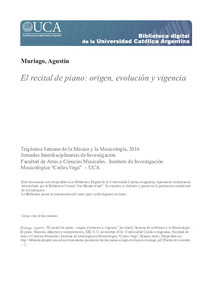Please use this identifier to cite or link to this item:
https://repositorio.uca.edu.ar/handle/123456789/1274| Título: | El recital de piano : origen, evolución y vigencia | Autor: | Muriago, Agustín | Otros colaboradores: | Jornadas Interdisciplinarias de Investigación : El piano: historia, didáctica e interpretación (13º : 2016 : Buenos Aires) Universidad Católica Argentina. Facultad de Artes y Ciencias Musicales. Instituto de Investigación Musicológica "Carlos Vega" |
Palabras clave: | PIANO; RECITALES MUSICALES; CONCIERTO; EVOLUCION | Fecha de publicación: | 2016 | Editorial: | Pontificia Universidad Católica Argentina. Facultad de Artes y Ciencias Musicales; Argentina. Instituto de Investigación Musicológica Carlos Vega | Cita: | Muriago, Agustín. “El recital de piano : origen, evolución y vigencia” [en línea]. Semana de la Música y la Musicología : El piano. Historia, didáctica e interpretación, XIII, 9-11 noviembre 2016. Universidad Católica Argentina. Facultad de Artes y Ciencias Musicales; Instituto de Investigación Musicológica “Carlos Vega”, Buenos Aires. Disponible en: https://repositorio.uca.edu.ar/handle/123456789/1274 | Resumen: | Resumen: Dado que el recital es el formato por excelencia para presentar música para piano, es importante analizar su origen, los cambios que fue desarrollando, y su validez en nuestra era. Tanto Franz Liszt con sus recitales virtuosos como Ignaz Moscheles con su ciclo de conciertos históricos, sientan las bases del formato así como también de ciertas convenciones, algunas de las cuales continúan vigentes al día de hoy. Sin embargo, desarrollos artísticos, sociales y tecnológicos fomentan cambios a través de la historia del recital. Uno de los más importantes es la transformación del recital de un evento comunal a uno de contemplación individual. En el marco de los cambios que ha experimentado el recital, es válido preguntarse en qué dirección se dirige. El interés por preservar la tradición del recital ignora el hecho de que nuestros conciertos actuales en poco se asemejan a los ofrecidos por quienes gestaron este formato. Al contextualizar el recital de piano resulta lógico pensar que proponer un formato alternativo que se adapte mejor a nuestro público es natural, posible, e incluso necesario. Abstract: Given that the recital is the quintessential format to present solo piano music, it is important to analyze its origin, the changes it underwent, and its validity in our time. Both Franz Liszt with his virtuoso recitals and Ignaz Moscheles with his series of historical concerts, lay the groundwork for the format and for certain conventions, some of which remain current to this day. Yet artistic, social, and technological developments set forth changes throughout the history of the recital. One of the most significant ones is the shift of the recital from a communal event to one of individual contemplation. In light of the changes that the recital experienced, it is worth wondering the direction it is moving towards. The interest in preserving the recital tradition ignores the fact that our modern recitals bear little resemblance to the ones performed by the creators of the format. By contextualizing the recital it seems logical to think that suggesting an alternative format that better suits our audience is natural, possible, and even necessary. |
URI: | https://repositorio.uca.edu.ar/handle/123456789/1274 | ISBN: | 978-987-620-323-4 | Disciplina: | MUSICA | Derechos: | Acceso Abierto | Fuente: | Jornadas Interdisciplinarias de Investigación : El piano: historia, didáctica e interpretación (13º : 2016 : Buenos Aires) |
| Appears in Collections: | JII 2016 13a. |
Files in This Item:
| File | Description | Size | Format | |
|---|---|---|---|---|
| recital-piano-origen-evolucion-muriago.pdf | 376,05 kB | Adobe PDF |  View/Open |
Page view(s)
1,282
checked on Apr 30, 2024
Download(s)
1,992
checked on Apr 30, 2024
Google ScholarTM
Check
Altmetric
This item is licensed under a Creative Commons License

